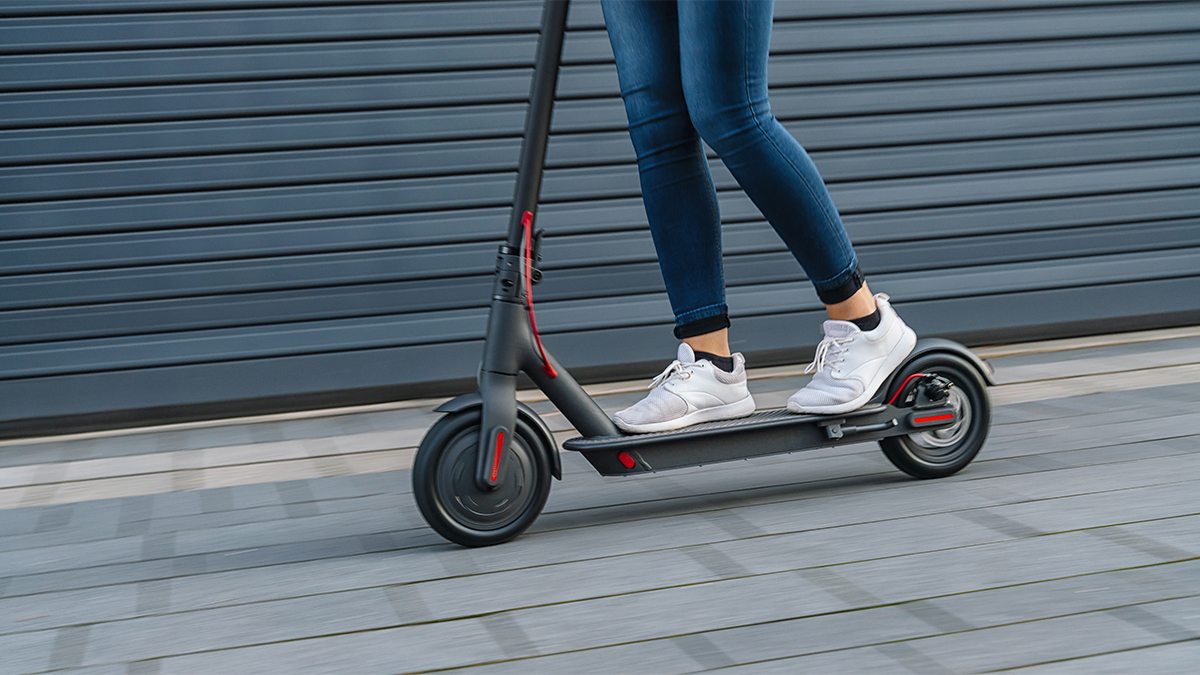Infrastructure needed for e-scooter safety
A boom in ridership has left municipalities playing catch-up, a UNC Highway Safety Research Center study finds.

If you spend any time on Carolina’s campus, you’ve probably noticed the proliferation of electric scooters over the last five years. As a pedestrian, it’s easy to blame e-scooter-related problems — crashes, usage on sidewalks, parking in inconvenient and sometimes dangerous locations — on their riders. But the findings of Carolina researchers working on a nationwide study show that many of the problems accompanying a growing e-scooter ridership more accurately reflect a lack of local infrastructure to support the emerging technology.
On March 5, the Behavioral Traffic Safety Cooperative Research Program — a collaboration between state and federal transportation agencies managed by the Transportation Research Board of the National Academies of Sciences, Engineering and Medicine — completed a nearly three-year-long study on e-scooter safety.
A surge in American e-scooter ridership around 2018 prompted the program to fund the study, one of the first on e-scooter safety.
E-scooter injuries in the U.S. tripled from 2014 to 2018, the study finds.
“In some cases, they were dropped overnight into cities and were showing up on the sidewalks,” said Laura Sandt, who led the study as its principal investigator.
Sandt is a senior research associate at the UNC Highway Safety Research Center and director of the Pedestrian and Bicycle Information Center. She also directs the nationwide, federally funded Collaborative Sciences Center for Road Safety.
“There was a lot of concern and interest, and people wanted to understand if e-scooters were safe or where they could be ridden safely,” Sandt said.

Laura Sandt
The study identifies some of the most frequent causes of e-scooter-related injury and offers changes that communities and policymakers across the country can implement to make roads and sidewalks safer for riders and pedestrians. The goal is proactive and equitable risk prevention.
Riders and risks
The study finds that e-scooter ridership is skewed toward people who are white, middle-income, male, aged 18-34 and live in urban areas. These trends may be connected to the concentration of shared e-scooter programs in downtown areas and on university campuses.
Some of the top injury and fatality risks for e-scooter riders that the study names include unsafe road surface conditions, low visibility and collisions with motor vehicles.
While most e-scooter injuries are minor and occur from falls due to loss of balance or collisions with objects other than vehicles, most of the recorded data points come from hospitals and therefore involve more serious injuries. Fatal incidents are rare — there have been 69 known e-scooter fatalities in the U.S. — and none has been reported in North Carolina.
The study shows that 90% of all e-scooter injuries occur off the roadway and do not involve a motor vehicle.
“A pothole even 6 centimeters deep could cause a significant fall and possibly injury,” Sandt said. “We spent a lot of time trying to understand those micro-hazards in the built environment that wouldn’t affect a driver or, in most cases, even a bicycle rider, because they have a wheel size that can easily get over those kinds of surface issues. But for e-scooters, sometimes the smallest issue — a grate or a pothole — can cause a rider to lose control.”
The findings indicate that helmet use is low across e-scooter users, and often lower than bicycle helmet use. Of the e-scooter injuries that required medical treatment, head injuries were the most common type, ranging from 28% to 40%.
“Helmet use is tricky because we know that a lot of helmets are not designed for all road users,” Sandt said. They may be uncomfortable if they’re not designed to fit with certain hair types, for example.
When compared to injuries sustained in bicycle crashes, e-scooter crashes had a higher rate of head injuries in the same cities during the same time period, the study notes.
“We do see helmets as an important tool for reducing certain injuries to the brain — they can certainly be the difference between a significant lifelong disability and an easier recovery in some lower-speed, less traumatic incidents,” Sandt said. “But we don’t want to overplay helmets as a prevention tool. Helmets don’t prevent crashes; they can reduce the severity of some types of injury.”
Among fatal injuries worldwide, almost 80% involve a collision with a motor vehicle, and they are more likely to occur at night.
According to the study, e-scooter nighttime ridership is higher than that of bicycle riders.
“One thing we’ve taken away from the study is how important it is to provide safe facilities for use at any time of the day,” Sandt said. “Not just daytime riding, but to think about those higher-risk conditions at night, when visibility is lower and people may be more vulnerable if drivers are tired, distracted or even impaired and not particularly looking for an e-scooter rider.”
Better infrastructure needed
While riders can — and should — wear helmets, look out for hazards and be mindful while riding, much of the onus for safety falls on the community’s urban planners, program leaders and policymakers, Sandt said.
“A lot of the study findings are most relevant to the people who plan the roadways,” she said. “E-scooter riders are going to ride where they feel the safest — and oftentimes that’s going to be as far as they can get from fast-moving vehicles.”
Often that means sidewalks, which aren’t designed for the high speeds that e-scooters can reach. On sidewalks there is also a higher risk of collisions with pedestrians or cars coming out of driveways. Dedicated bicycle facilities are an important alternative to sidewalks that can better accommodate e-scooter riders in most cases.
According to the study, roads with separated or protected bicycle lanes had fewer e-scooter injuries, lower rates of sidewalk riding and higher perceptions of comfort among riders.
One study survey received more than 200 responses from agencies about their practices and approaches to e-scooter safety management. The most common policies were around the e-scooter vendor permitting stage or public safety messaging. Very few communities established clear vehicle speed management efforts, safety and equity plans, data collection efforts or emergency response plans. State laws about e-scooter use are inconsistent, if they exist at all, and there is no clear guidance at the federal level.
Based on their findings, the researchers suggest that state highway safety officials and other policymakers focus on three key takeaways:
- Supporting local agencies in defining emerging transportation devices and prioritizing the safety of vulnerable road users when creating legislation.
- Improving the standards for e-scooter safety data collection and supporting local program evaluation.
- Providing more local funding and program support at the state level and coordinating with partners like emergency service providers to share plans and safety data.
Other challenges
College campuses like Carolina’s face their own unique challenges.
The study notes that one of the most dangerous combinations of risk factors is when e-scooters are available in close proximity to high-speed traffic, large vehicles and establishments that provide opportunities for binge drinking.
Additionally, the survey responses from college towns reflected the importance of clear communication around e-scooter usage. Carolina, for instance, offers guidelines to encourage safe e-scooter practices.
Parking creates another problem. Not only is it inconvenient to have scooters in the middle of walkways, it can also be a hazard and a violation of the Americans with Disabilities Act.
“You can imagine that if people were allowed to park their cars anywhere, it would be total chaos,” Sandt said. “We create designated parking spaces for cars, and e-scooters need that investment as well.”
Many of the initial communities to adopt e-scooter technology were faced with a dilemma — there was no parking infrastructure in place, and the sidewalks were a convenient “dumping ground” for e-scooters. “In many cases, they were impeding access to curb ramps, which can affect travel for people in wheelchairs,” Sandt said.
She said the study focuses on improving safety and accessibility not only for e-scooter riders but also other road users and pedestrians. To do so, the researchers looked at communities that have implemented various e-scooter parking policies.
“Some cities replaced car parking with e-scooter parking hubs and tried to attract e-scooters to the places and facilities that were really intended for them,” Sandt said.
The study’s findings show that parking compliance was highest in cities with clearly established e-scooter parking areas.
All of the suggestions for planners and policymakers are designed to help communities be proactive about identifying and mitigating risks.
“E-scooters have been polarizing in many communities,” Sandt said. “Some people love them. They see the immediate benefits in terms of convenience or cost or even just how fun they are. But some people certainly see them as a nuisance.”
But e-scooters have become a significant part of today’s transportation landscape, she said. Like it or not, “They’re here to stay.”
7 ways to practice e-scooter safety
While the study focuses primarily on things city planners can do to prevent e-scooter-related injuries, it does include a few suggestions for the public:
- Get familiar with the technology in a safe place before using it for the first time.
- Pay attention to any rules the community has in place, including University guidelines.
- Wear a helmet when riding an e-scooter whenever possible.
- Look out for hazards, like curbs, light poles, manhole covers and grates, and uneven surfaces, cracks and potholes.
- Don’t ride an e-scooter while impaired.
- Be especially cautious riding at night or anytime visibility is low.
- Be respectful of other road users, especially when choosing a place to park.




